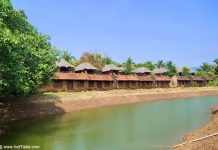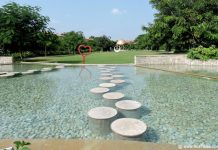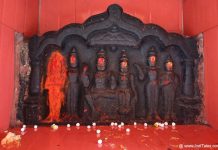The moment I heard of Bhojpur, I was reminded of the famous Hindi saying ‘Kahan Raja Bhoj, kahan Gangu Teli’. A phrase that is commonly used to highlight the contrasts. The image of Raja Bhoj and hence his kingdom Bhojpur is that of something that has grandeur and prosperity which is incomparable. Today Bhojpur Shiva Temple or Bhojeshwar Temple is the only living glimpse of this grandeur.
Who was Raja Bhoj?
Raja Bhoj belonged to the Parmar dynasty, in the lineage of Vikramaditya of Ujjain. He ruled the Malwa region between 1010-1055 CE. His capital was Dharanagari which is now known as Dhar. The place was known for sharp swords, hence the name Dhar.

He was a powerful king whose military campaigns went far and wide. Bhoj Raja built many temples and probably had plans for even grander temples. He was responsible for building lakes in and around present-day Bhopal. In fact, Bhojeshwar Temple was located next to a huge lake called Bhimtal. It was a giant lake built by building dams on the river Betwa.
A lesser-known fact about Raja Bhoj is that he authored about 84 books on subjects ranging from architecture to philosophy to medicine to music. He was a rare polymath, a scholar king who was believed to have brought Saraswati to earth. Bhojashala in Dhar is a testimony to this. Udaipur Prashasti – an inscription tells us that he built as many as 104 temples in Dhar. None of them unfortunately survive.
Bhopal also gets its name from Raja Bhoj. It was originally called Bhojpal that over a period became Bhopal.
Krishnadevaraya of the Vijayanagara Empire named himself as Abhinava-Bhoja and Sakal-Kala-Bhoja after Bhoj Raja.
Bhojpur Shiva Temple – Bhojeshwar Temple
What is left of Raja Bhoj’s Bhojpur, is an unfinished but practicing Shiva temple in dark stone. Bhojeshwar temple was built in the mid-11th century during Bhoks’s rule. It was never completed. In its incomplete state, it gives us a lot of insights into the making of temples.
Huge Shivalinga at Bhojpur Shiva Temple

This temple is famous for the huge Shivalinga that it adorns. As we know, Shivalinga has two parts Linga and the Yoni. The lower platform-like part is called Yoni. The yoni in this temple is probably the biggest you would ever see. The linga part is definitely not the largest, as a Matageshwar temple in Khajuraho has a much bigger Linga. The yoni here is huge and beautiful.
Shivalinga here is made in layers of limestone. The total height of Shivalinga is about 40 feet.

The ceiling of the temple is ornamental, with a design in the form of concentric circles. Quite like the temples in Khajuraho.
There are four octagonal pillars at the temple and the walls seem to have been put up later. Or maybe restored recently as they look too bland in comparison to the rest of the temple. The brackets above pillars have Shiva Parvati, Brahma Brahmani, Lakshmi Narayana, and Ram Sita.
My guess would be probably the temple was open standing on the four pillars. Like many other Shiva temples, I have no data to support that.
The architecture of Bhojeshwar Temple
The temple is built on a huge platform or Jagati, as was prevalent in those days.

A mandapa or a hall is missing in the temple. The temple is standing freely on Jagati.
Shikhara of the Garbhagriha is rectilinear instead of the unusual curvilinear ones we see in the typical Nagara Style of Temple Architecture. Carvings of apsaras, ganas, and other deities can be seen only on the front side, the other walls are plain, probably waiting to be carved with stories of Shiva.
Some scholars argue that this may be Swargarohan Prasada or a temple built in memory of a deceased ancestor based on the shape of the Shikhara.

Ramp to Port Stones
On the right side of the temple, there is a huge ramp. This was probably used to bring the stones up on the platform for constructing the temple. But for this ramp, we would have kept wondering how the huge stones and sculptures were ported on top of the platform. Or, even to build the platform on how the stones were ported.
Remember the huge stone on Brihdeeshwara Temple at Thanjavur was also taken up using a long ramp.

A stone quarry close to the temple had many carved stones in different stages. These are now with ASI. There are architectural drawings that are etched on the stones surrounding the temple. This indicates the plan for a huge temple complex. We also get to see Mason’s marks on the stones which would be part of managing the project plan.
There are two small temples outside the main temple which are also practicing ones. The outer wall on the right-hand side of the temple has some unfinished artwork. This gives you a glimpse of how the work progressed as the temples were built.
Excavations
Apparently, the excavations at the place have revealed that the intent and plan was to build more temples in this place. Probably a kind of temple complex like the one in Khajuraho. It seems the plans had to be shelved mid-way due to unknown reasons.

Bhojeshwar temple was finished to the extent that Shivalinga was installed and the worship started. It continues to be a practicing temple to date.
A Mahashivaratri mela takes place every year here.
Other places to see in Bhojpur
There is a Bhojeshwar Temple Museum close to the temple that takes you through the history of the region through the lens of this temple.
As you stand on the huge temple platform and look around, you would see the creations of modern India. You see a line of huge factories throwing a constant stream of thick black smoke from their gigantic chimneys. Smoke forms the skyline of the neighboring industrial town of Mandideep.
An unfinished Jain temple dedicated to Shantinath ji is also there in the town.
Parvati Cave located in a gorge of Betwa was used by many saints for their Sadhna.
Some ruins of Raj Bhoj’s palace can be seen close to the temple. You will have to use your imagination to think of it as a palace as it was exactly defined in Bhoja’s book Samarangana Sutradhara.
How I wish I had lived in the times of prosperity in this land. Instead of going from place to place tracing ruin after ruin, I would see the epitome of aesthetics and prosperity in India.
Travel Tips
Bhojpur is about 32 km from Bhopal. You can easily do this temple as a day trip from Bhopal, which is well connected by air, rail, and road.
You may need an hour or so to see the temple.













Wat a work in stone …..
hi anuradha………
i was searchin 4 sumbody who is interested in history kinda things and i found u.apart from this am new to blogging .i have joined yesterday only,ur knowledge and interest about historical things is quite amazing.do u visit these sites or u just read about these places from somewhere.
anyways nice blogs related to history others are not of my interest as i cant be philosphical like u……
gud work keep it up ….
Hi Bannaji,
I write about only those places that I have visited and use only my own pictures.
Thanks for your compliments.
-Anu
thnx anu for replying……..
its nice 2 know that u use originals.
by the way if u need any help related to rajasthan i’ll surely provide u if that’ll b in my domain.
Sure Bannaji, I will ping you as and when I visit Rajasthan.
Regards
no prob. i’ll surely help u and please let me know abt the new posts by u related to historical things…….i’ll b grateful to u…